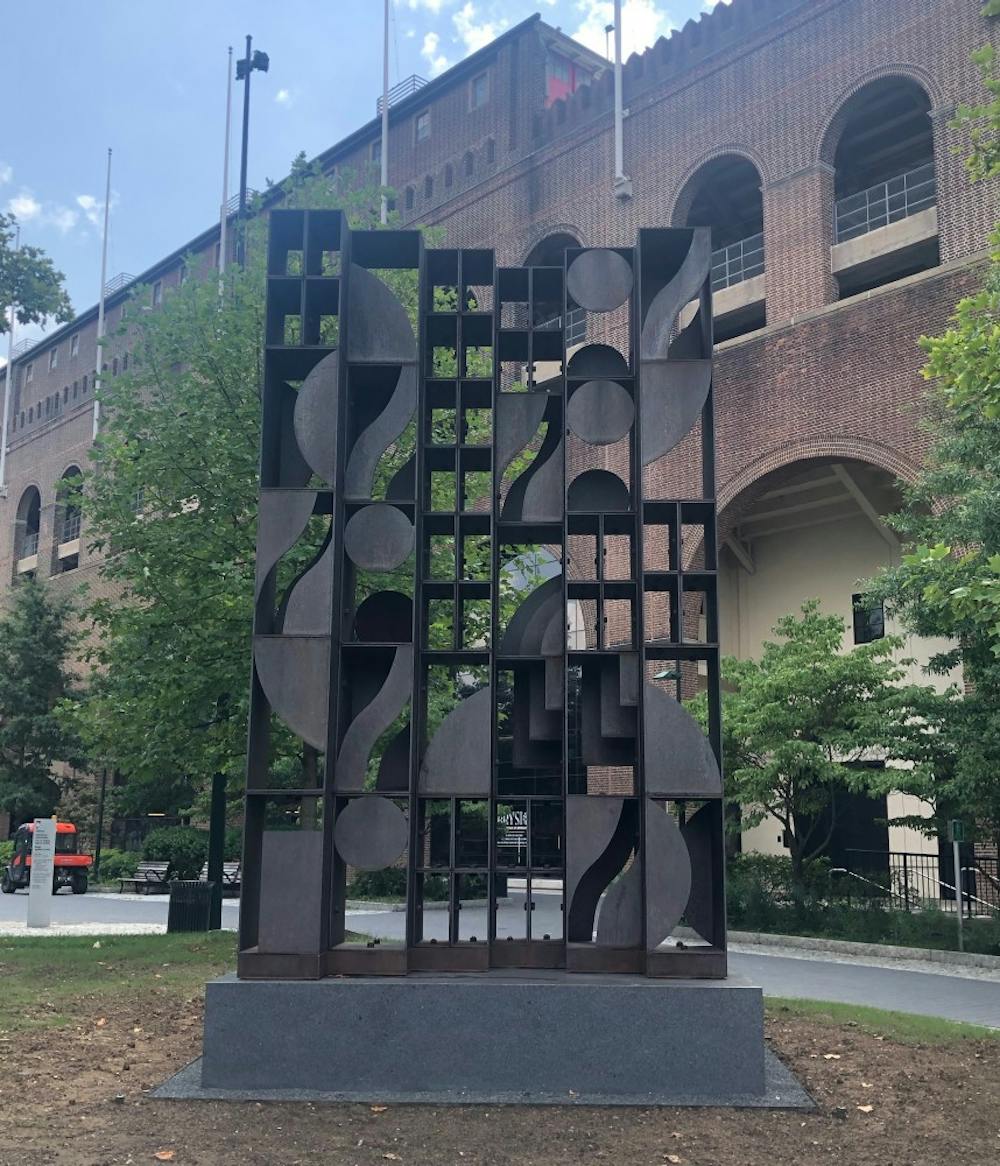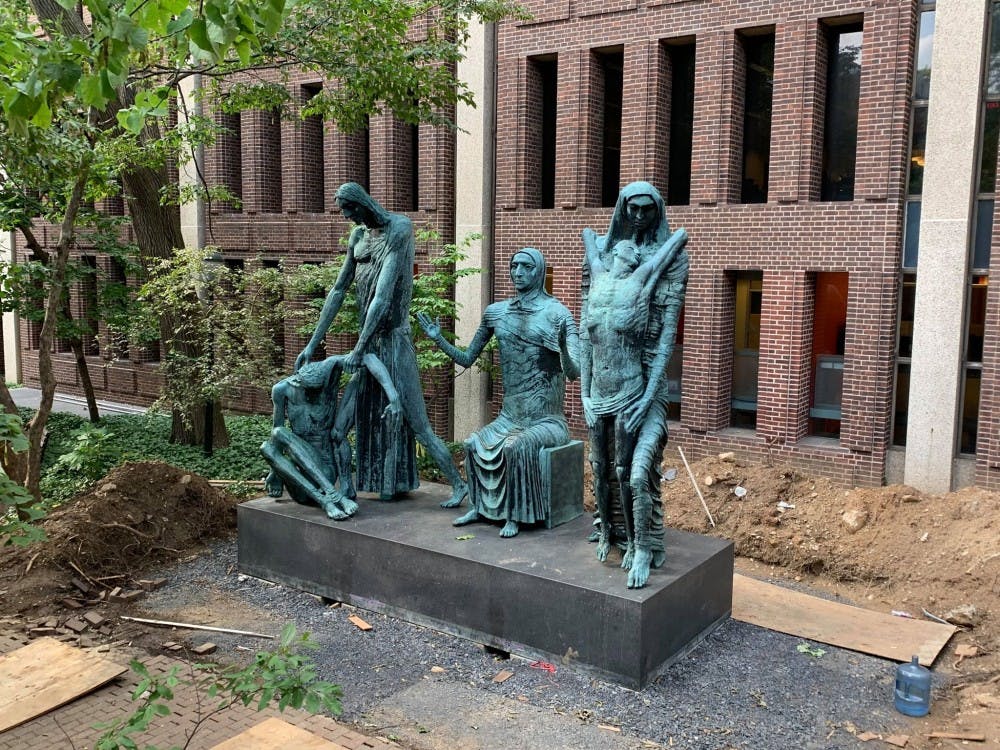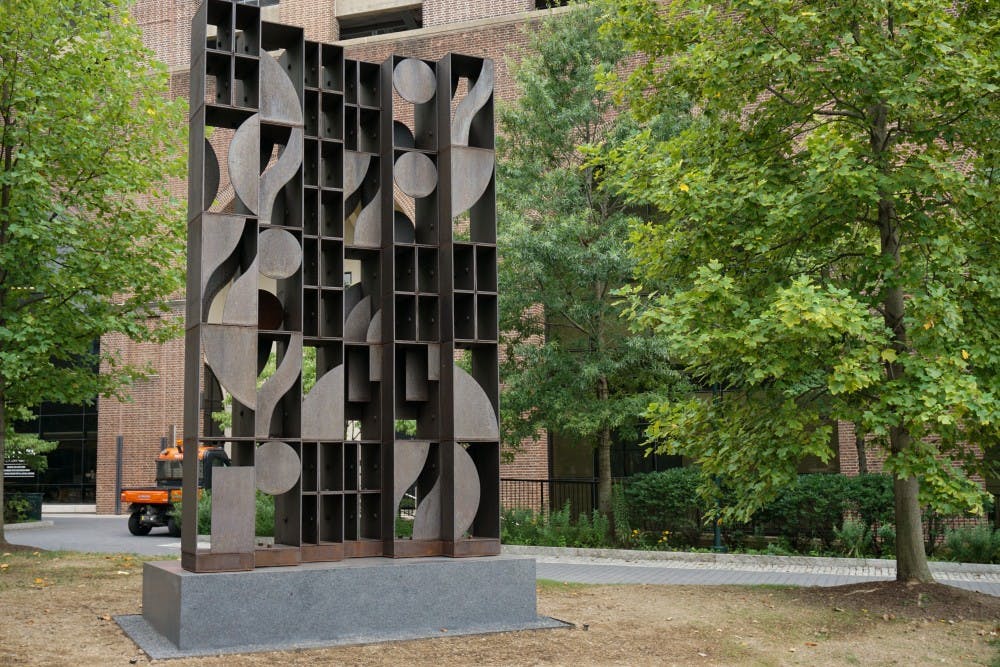Penn’s campus is full of memorable public sculptures. Who hasn’t taken a photo by the Love statue, or walked under Covenant—the official name for the tall red beams on Locust? Now, with a long–term loan from the Association for Public Art for 99 years, Penn's sculpture collection grows even bigger. The relocation of two large–scale, outdoor sculptures—Louise Nevelson’s Atmosphere and Environment XII (1970) and Sir Jacob Epstein’s Social Consciousness (1954)—began in mid–July. Atmosphere and Environment XII has been placed on Shoemaker Green, and the installation of Social Consciousness is well underway at the Memorial Garden Walkway.
The sculptures had stood at the West Entrance of the Philadelphia Museum of Art for decades, with Social Consciousness since 1955 and Atmosphere and Environment XII since 1973. However, with extensive renovations going at the PMA—including on the West Entrance itself—the Association for Public Art (aPA) decided to look for new homes for these sculptures, where they could still be viewed and appreciated by the public. After approaching Penn with a proposal, Penn’s Art Advisory Committee and aPA worked together to choose the locations.
“We wanted to keep these important artworks in continued public view and avoid placing them in long–term storage, which sometimes is inevitable in situations like this one,” said Penny Balkin Bach, Executive Director and Chief Curator of aPA, in a press release. “We are thrilled to have worked with the University of Pennsylvania to add to the collection of public art on their campus, where the sculptures can be viewed and appreciated by new audiences, and revisited by their existing fans in a different setting.”
Released from their sentry at the PMA, and repositioned on Penn’s campus, the sculptures offers an unique opportunity for those visiting or living at Penn. “These pieces will fit perfectly among our sculptures and become integral to experiencing Penn’s campus,” said Lynn Marsden-Atlass, University Curator and Executive Director of the Arthur Ross Gallery, in the press release. Now, how these statues can affect our experience on campus is entirely up to us.
As large, contemplative sculptures, the presence of Atmosphere and Environment XII and Social Consciousness can both enrich the campus conversation around institutional art and value, and present the sculptures themselves in a new, reflective light.

Atmosphere and Environment XII sits atop a low hill on Shoemaker Green, against Franklin Field on one side, and the grass fields on the other. Its creator, Louise Nevelson, is one of the most influential artists in the decades after World War II. Immigrated from modern–day Ukraine to America as a child, she is known for dramatic, monochromatic sculptures that incorporate abstract forms. Atmosphere and Environment XII, made of 18,000 pounds of steel, showcases Nevelson’s style. It includes six columns of open rectangular cubes bolted together, within which abstract shapes interplay. “Nevelson’s ‘environments’ mimic modern cityscapes and outlines,” said Bach. “At this new site, an open space surrounded by buildings, we will see the interplay between the architecture and the sculpture.”
Today, you can walk around Atmosphere and Environment XII, and see the city through its eyes. The sleek shapes—combined with the rusting, gray steel—separates its environment into its most basic units. Whether it is the arches of Franklin Field, or the modern Towne Building in the distance—by being at Penn, Atmosphere and Environment XII asks us to think about our surroundings—the architecture, nature, and the people. With its at once fluid and monumental form, Atmosphere and Environment XII reflects these elements and their often tricky relationships. The next time you are lying on Shoemaker Green, check out this new sculpture, and see what it tells you about where you are.

Social Consciousness, by Sir Jacob Epstein, will also be placed at an especially fitting location on campus. According to the press release, “it will be placed in a more contemplative site than its current location [at the PMA], consistent with the artist’s intentions.” Originally commissioned in 1950 by the aPA (then the Fairmount Park Art Association) for the Ellen Phillips Samuel Memorial, the sculpture became too big for that location. Today, it will be along the Memorial Garden Walkway near Van Pelt, surrounded by shady greenery and benches.
Born in U.S. to Polish Jewish refugee parents, Epstein later immigrated to England and became known as an often controversial sculptor. Social Consciousness, meant to represent the American ideal of compassion, is made of three solemne female figures: the Eternal Mother (center), Compassion (left), and Succor (right). While the Eternal Mother looks out at the visitors with sorrow, Compassion reaches for a collapsed youth at her feet, and Succor (or Death) supports a young man bending backwards to embrace her.
Since their conception, these towering figures have attracted many criticisms, including for being unnatural or disjointed. At first glance, their sharp, angular bodies—almost painfully exaggerated—can feel unnerving. However, that may be the point of the sculpture: even as it evokes the tenderness of compassion, it does not shy away from the faults and vices that make our compassion necessary. Whether you are sitting on the Walkway, or strolling through it to class, Social Consciousness can be a sharp reminder of the two sides within the human condition.
Nevelson’s Atmosphere and Environment XII and Epstein’s Social Consciousness are great, evocative additions to Penn’s campus. The former reflects where we are, and the latter who we are. They offer many opportunities to think—how do we fit into the larger Philly cityscape, how can we be compassionate, and why are those things especially urgent today? If you get a chance, don’t wait until 2118 to take a look at these new additions.

